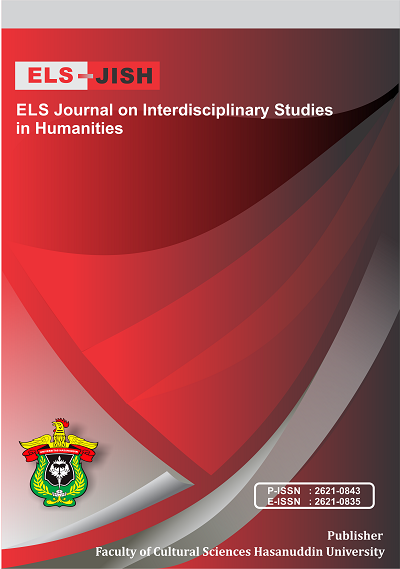An Analysis of Word Formation Processes Found in TikTok Application
DOI:
https://doi.org/10.34050/elsjish.v7i1.33150Keywords:
Application, TikTok, Word Formation ProcessAbstract
This research explores the process of words formation and its impact on the part of speech of words in data words formation processes. This research used descriptive qualitative data, by using observation and capturing the data. Data source in this study is TikTok of Charli Grace D’Amelio. The data in this research are taken from the captions, hastags, and comments or words that consist of morphological process in TikTok of Charli Grace D’Amelio. The researcher used the theory of Delahunty and Garvey (2010) and Plag (2003) which divides word formation into 8 types these are compounding, abbreviation, blending, affixation, coinage, conversion, acronyms, and borrowing. The result of the data showed that the researcher found 11 words formation of compounding, 7 words formation of abbreviation, 2 words formation of blending, 8 words formation of affixation, 7 words formation of coinage, 8 words formation of conversion, 16 words formation of acronyms, and 2 words formation of borrowing. The data findins and analysis from Charli Grace D’Amelio TikTok page indicate a predominant use of acronyms in word formation processes. The researcher presumed that the implementation of word formation by the users of TikTok inform that sometimes they wrote something inappropriate way such as acronym. They wrote them in lowercase other than to be written in uppercase. TikTokers tend to ignore the rule of word formation. It can be concluded that the aim of different types of word formation processes assisted people to understand the function of each word formation processes in order to avoid mistake in their writing. People have to use types of word formation processes which depend on their functions.
References
Andini, C., Sosrohadi, S., Fairuz, F., Dalyan, M., Rahman, F. F., & Hasnia, H. (2022). The study of Japanese women in the facial treatment advertisement: a semiotics perspective of Pierce’s Theory. ELS Journal on Interdisciplinary Studies in Humanities, 5(2), 337-347.
Adriyana. Iswatiningsih, D. Mahmud, J. Yulianti Evi, O. Trang, T. (2021). Tiktok Terhadap Variasi Bahasa Kolokial pada Kalangan Remaja Indonesia (Kajian Etonolinguostik). Fon : Jurnal Pendidikan Bahasa dan Sastra Indonesia, 17(1), 34-41. doi:https://doi.org/10.25134/fjpbsi.v17i1.3957
Bauer, L. (1983). English Word Formation : Published by the Press Syndicate of the University of Cambridge. Printed in Great Britain : Cambridge University Press.
Booij, G. (2012). The Grammar of Words: An Introduction to Linguistic Morphology. Oxford: OUP Oxford.
Delahunty, G. P., & Garvey, J. J. (2010). The English Language: From Sound to Sense. Colorado: WAC Clearinghouse.
Jin, Y., Han., K., Shih, P., and Lee D., (2015). Generation Like Comparative Characterisctics in Instagram. In Acm Conference on Human Factors in Compating Systems.
Kosinski, M., Matz, S. C., Gosling, S. D., Popov, V., & Stillwell, D. (2015). Facebook as a research tool for the social sciences: Opportunities, challenges, ethical considerations, and practical guidelines. American Psychologist, 70(6), 543–556. https://doi.org/10.1037/a0039210
Luthfiyati, D. Kholiq, A. Zahroh, N.I. (2017). The Analysis of Word Formation Processes in the Jakarta Post Website. Linguistic, English Education and Art (LEEA) Journal 1(1):30 - 36.
Machmoed, H. A., Sahib, H., & Hakim, A. (2023). Discourse Analysis Of Skin Care Advertisements On Social Media Based on Language Structure And Function. International Journal Of All Research Writings, 4(7), 1-6.
Maroof, R. Ayoubi, K. Alhumaid, K. Aburayya, A. Alshurideh, M. Alfaisal, R. Salloum. S (2021). The Acceptance of Social Media Video for Knowlegdge Acquisition, Sharing, and Application : A Comparative Study Among Youtube Users and Tiktok Users for Medical Purposes. International Journal of Data and Network Science 5, 197-214.
Mou, B.J. (2020). Study on Social Media Marketing Campaign Strategy – TikTok and Instagram. Jacob Cohen Senior Associate Dean for Undergraduate & Master's Program MIT : Sloan School of Management
Montag, C., Yang., H., Elhai., J.D. (2021). On the Psychology of Tiktok Use. A Glimpse From Empirical Findings. Volume 9- 2021 https://www.frontiersin.org/articles/10.3389/fpubh.2021.641673/full
Mustafah, Z.S. Kandasamy, M. Yasin, M. (2015). An Analysis of Word Formation Process in Everyday Communnication on Facebook. International Journal of Education and Research Vol.3 No.6 June 2015, ISSN : 2411-5681
Octavia, E., & Zaim, M. (2022). An Analysis of Word Formation Processes Used by Food Vloggers. English Language and Literature, 11(3), 263-274.
Plag, I. (2003). Creoles as interlanguages: Word-formation. Journal of Pidgin and Creole Languages, 24(2), 339-362.
Puturuhu, G. Zefanya, Y.R. Wibisono, N. (2021). English Language and Literature as Media of Communication During Pandemic, ISBN : 978-623-7601-15-9.
Rahman, F., Abbas, A., Hasyim, M., Rahman, F., Abbas, A., & Hasyim, M. (2019). Facebook group as media of learning writing in ESP context: A case study at Hasanuddin University. Asian EFL Journal Research Articles, 26(6.1), 153-167.
Rahman, F., & Weda, S. (2019). Linguistic deviation and the rhetoric figures in Shakespeare’s selected plays. XLinguage" European Scientific Language Journal", 12(1), 37-52.
Sharabati, A. A. A., Al-Haddad, S., Al-Khasawneh, M., Nababteh, N., Mohammad, M., & Abu Ghoush, Q. (2022). The impact of TikTok user satisfaction on continuous intention to use the application. Journal of Open Innovation: Technology, Market, and Complexity, 8(3), 125.
Sukmawaty, Rahman, F. F., & Andini, C. (2022). Covid-19 Pandemic and Axiology of Communication: A Study of Linguistic Phenomena. IJISRT, 7(4), 1079-1087.
Vlietstra, J. (2012). Dictionary of Acronyms and Technical Abbreviations: for IT, Industrial, and Scientific Applications. London: Springer.
Yaumi, M. T. A. H., Rahman, F., & Sahib, H. (2024). Bridging Language and Technology through Semiotic Technology. International Journal of Social Science Research and Review, 7(1), 52-61.
Zhu, L., Zhang, M., Xu, J., Li, C., Yan, J., Zhou, G., ... & Liu, F. (2022). Single-junction organic solar cells with over 19% efficiency enabled by a refined double-fibril network morphology. Nature Materials, 21(6), 656-663.
Downloads
Published
Issue
Section
License
Copyright (c) 2024 Iffah Al Hikmah, Hamzah Machmoed, Harlinah Sahib

This work is licensed under a Creative Commons Attribution-ShareAlike 4.0 International License.






